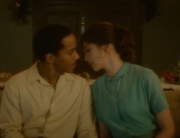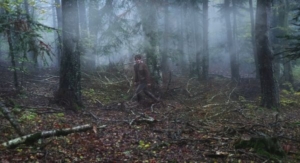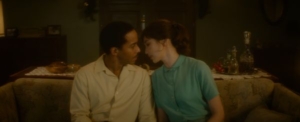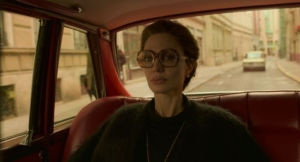Intricate and occasionally sumptuous, Emily Packer’s Holding Back the Tide is a free-flowing, part meditation, part tone poem, and part documentary on oysters, set around the waters of New York City. Going into the film without knowing the subject matter, as I did on the first watch, is perhaps the ideal way to ingratiate oneself to this somewhat untethered piece. It’s imbued with rich tiny details that pop in subsequent viewings. Unique and intriguing, the free-form essay focuses upon labor within oyster industries—whether it be farmers, shuckers (of past and present), or restoration groups like the Billion Oyster Project, which aims to rebuild oyster reefs in New York Harbor. It also effectively spotlights environmental issues as well—the erosion of shorelines, the disappearance of oysters and reefs, climate-change induced storms such as Hurricane Sandy, and the pollution of the Gowanus Canal—and the efforts to reverse the damage.
Packer intermixes lush, staged narratives, such as artist/activist Dragonfly as an Aphrodite figure with windblown hair upon the bow of a ferry at dusk in the alluring opening (shot beautifully by cinematographer John Marty) or gazing dreamily along a shoreline. Besides Wilson, the film is populated with other queer actors and artists like TL Thompson and Hannah Rego. In one sequence, Thompson narrates the plight of Black oystermen in the early 20th century working arduous hours in the still-standing historic Rudolph Oyster House. Rego re-creates an oil still life painting of a platter of lush fruit and oysters. Even if some of these asides, such as a couple relishing an oyster fleet in a Grand Central Terminal restaurant, feel a bit strained and muddled, Packer’s idiosyncratic vision is welcome.
When there is a collision between verité and the cinematic, the film sings, as when a group of New Yorkers, many of whom are trying oysters for the first time, sample them, with cuts to splashy Brooklyn fountains, backed by a soaring “Nessun Dorma.” Perhaps the most ravishing sequence interlaces a flooding, rain drenched subway station, with shots of teal, aquatic mosaics on station walls depicting humans with sea life and haunting visuals of retired subway cars being dumped into oceans to create artificial reefs. A Union Square farmers market sequence offers close-ups of fish wrapped in plastic baggies for Covid-masked shoppers as a windsock in the shape of a fish hovers above a street. In these scenes and others, Packer illuminates paradoxes and the constant fusions and relationships between synthetic and natural worlds. The airy, ambient score, primarily made up of pieces by Arooj Aftab and original contributions by MJ Guider and Abby Swidler, adds to the ruminative mood. Credit too should be given to Lindsey Phillips and Benjamin Stillerman for their delicate editing between a myriad of visuals.
Perhaps at the core of Holding Back the Tide is the magnetic oyster farmer Sue Wicks (also a former WNBA player). Grounded and determined in her work, she espouses many of the film’s themes and symbols of queerness and transness in what she says: “They [oysters] start out as female and then they change to male. Depending on the balance of male, female in the water. It’s always the harmony and balance of what needs to be done… It’s not just arbitrary that they can switch back and forth.” The moments with her, mostly under greyish skies, aren’t flashily filmed, but are compelling. Sometimes what’s simple is more effective, and one wonders how Packer’s film would have been without the narrative re-creations, but the ambition on display and the film’s sense of freedom from typical constructs make it a completely unusual experience.

















Leave A Comment